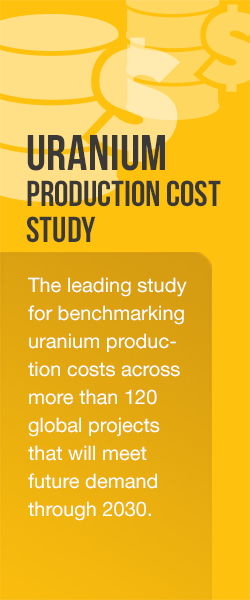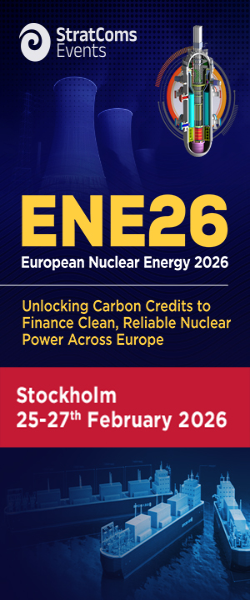Atoms for Peace Turns 50
Today is the 50th anniversary of President Eisenhower’s Atoms for Peace speech. As this is a subject of great interest to me, I would like to take this opportunity to reflect personally on developments over the past year to bring attention to this anniversary, what we tried to do in this regard, and what we have learned along the way.
Last year at this time, we noted the advent of this special anniversary and opined how this represented an excellent opportunity to reflect upon the past accomplishments of the atom as well as to address future challenges. To this end, we recommended that special conferences be held and that sessions within ongoing conferences be devoted to commemorating the fiftieth anniversary and bring additional attention to the positive role of the atom. We pledged to “do what we can” to promote this celebration.
A Year of Notable Meetings – One primary focus was that a meeting or meetings be held to commemorate this important speech. To this end, we sought out an organization that might sponsor such a meeting. This met with some success early on, as the Foundation for Nuclear Studies liked this idea and hosted a one-day seminar on Atoms for Peace at the Capitol. We also spoke to officials at the Department of Energy about the need to have a special meeting celebrating the anniversary of the speech. They also embraced the idea and responded by co-sponsoring an illuminating one-day conference. (see “Atoms for Peace + 50,” The Ux Weekly, October 27, p. 1-2).
We mention our role not to give ourselves credit but to show that we were sincere in our intentions and how individual efforts can make a difference, a lesson that can perhaps be applied to promoting nuclear power for the next 50 years. And, while we served as a provocateur in these matters, we must acknowledge that we had almost nothing to do with the specific content of these meetings. Also, it was certainly no secret that the fiftieth anniversary of the speech was approaching, and nuclear energy organizations would seek to incorporate this theme in their regular meetings. Such was the case with the Nuclear Energy Institute, which is also celebrating its fiftieth anniversary, the World Nuclear Association, and, just last month, the American Nuclear Society.
In addition, there were other special meetings that were held to commemorate the speech. For example, last month Lawrence Livermore hosted a two-day symposium on how the speech affected nuclear technology, and we know of a similar symposium that took place in Japan in September. The occasion of the fiftieth anniversary also represented the opportunity to launch some innovative concepts, such as the World Nuclear University championed by the WNA’s John Ritch.
All in all, the nuclear industry responded magnificently to this anniversary, giving it the attention it deserved. Without exception, the meetings were uniformly excellent, some of the best that I have ever witnessed in my almost 30 years in this industry, although my perspective might be a little tainted since I’m an avowed Atoms for Peace junkie.
A Year of Discovery and Challenges – Attending as many meetings as I could, I have come away with a much greater appreciation of Eisenhower’s foresight and his unique capability to meet this task. As has been mentioned in these pages before, because of his prior experience of building up this nation’s military infrastructure in preparation for World War II, Eisenhower had the background to be able to reverse-engineer the military applications of the atom for peaceful uses. But, even more than this, he had a certain optimism about the future, which was desperately needed 50 years ago, as well as today.
I was also amazed to learn the extent to which the atom has contributed to the quality of life over the past 50 years. While use of nuclear weapons in a modern conflict can rightly be considered unthinkable, life without the benefits of the atom is now equally unimaginable. This is certainly true to some of us who have survived heart attacks and have come to appreciate the advances of nuclear medicine.
I also soon discovered how incredibly complex and even controversial this subject was. The atom has so many dimensions, as does the atoms for peace story itself. This includes trying to understand what the real motivations of Eisenhower’s action were, and what the real results were. While an aim of his initiative was to promote the use of nuclear technology for peaceful purposes, there was the question of whether this also accelerated the proliferation of nuclear weapons and weapons know-how, the dark side of the atom.
In this regard, it is somewhat ironic that in the year leading up to the fiftieth anniversary, there was more concern expressed about the misuse of the atom than has been the case for many years. Throughout the year, we were reminded almost constantly about the dangers of the atom, as the focus shifted from Iraq to North Korea to Iran. And, the United States went to war, at least in part to thwart the perceived threat that Iraq was developing nuclear weapons. And this special brand of irony persisted throughout the year. Almost 50 years to the day of Eisenhower’s speech, the United Nations was adopting measures against Iran to ensure that that country did not divert the atom from peaceful to military purposes. Of course, the organization that has the lead in keeping a check on Iran’s nuclear ambitions is the International Atomic Energy Agency, itself a direct product of Eisenhower’s speech.
All of the foregoing made it difficult to honor Eisenhower’s initiative in a way that would do this subject justice. How could all of these dimensions be adequately addressed in a balanced manner? Any discussions on the subject need to be more than a paean to the atom, in that they should consider the challenges that the atom poses as well as its accomplishments.
Atoms for Survival – When looking at a suitable theme regarding the atom over the next 50 years, various titles have been offered up such as “Atoms for Prosperity” or “Atoms for Humanity.” In our cover story of last year, we came up with “Atoms for Change.” These titles recognize that the peaceful uses of the atom have been demonstrated, and the next challenge is to extend these benefits to make the world a better place.
But, after a year of studying this issue, I have concluded that the best theme may be “Atoms for Survival.” While this is not catchy and indeed sounds downright ominous, it perhaps best captures the importance of the atom in the upcoming 50 years. Given the energy and environmental challenges during this time period, it is difficult to imagine the world making it without the contribution of the atom. With the global population growing to unprecedented levels, the atom’s role in food irradiation and water desalination will likely also be critical.
At the same time, this theme pays tribute to Eisenhower’s vision. If one accepts the proposition that the peaceful atom is essential to our future survival, then the speech, which advanced peaceful uses to ensure survival at an earlier time, is even more significant today.
Atoms in My Neighborhood – If you’d bear with me, I’d like to tell you a quick story pertaining to this discussion. Brian LaPlant, who lived directly behind my parents, was the liaison between the armed services and the executive branch in the early 1950s. One of his assignments was to personally deliver the message to President-elect Eisenhower that the United States had developed the hydrogen bomb. At the time, Eisenhower was playing golf at the Augusta National course, home of the Masters tournament. Brian gave the message to Eisenhower, who read and then burned it, after which he presumably resumed his golf game. The following year, after the Soviets developed their own hydrogen bomb, Eisenhower was moved to give his famous speech.
My parents lived in a most unusual neighborhood, populated by a four star general, a four star admiral, and a cabinet member, and a Congressman. Also in residence was Fletcher Prouty, the former Chief of Special Operations (clandestine activities) for the Joint Chiefs of Staff and Kennedy assassination conspiracy theorist extraordinaire. For those of you who have seen the movie JFK, he was the inspiration for Colonel X, played by Donald Sutherland.
The resident Congressman happens to be Lee Hamilton, former Chairman, Committee on Foreign Affairs, and current Director of the Woodrow Wilson International Center for Scholars. At a party given in my parents’ honor earlier this year, I quizzed Congressman Hamilton to whether his organization was going to do anything to commemorate the fiftieth anniversary of Atoms for Peace. Today and tomorrow, the Wilson Center is co-hosting, along with the Los Alamos National Laboratory and the College of William and Mary, “Atoms for Peace: A Future after Fifty Years?,” whose speakers include Energy Secretary Abraham, Senator Domenici and former Government official James Schlesinger. I don’t know whether my little entreaty had any effect, but it is somewhat satisfying that the atom has now come full circle, if only in my parent’s neighborhood.
The Road Ahead – Although the anniversary has been reached, there is plenty left to do. From the standpoint of looking forward, it is interesting to note that the topics of the meeting today are nonproliferation/arms control and nuclear safety/materials control. On December 9th, the first day of the next 50 years, the topics are, fittingly, nuclear energy and atoms for peace and future initiatives.
Looking ahead, we each need to build on Eisenhower’s vision with our own personal initiatives to support the peaceful uses of the atom and share its benefits more globally. One person can indeed make a difference. Dwight D. Eisenhower was proof enough of that.


